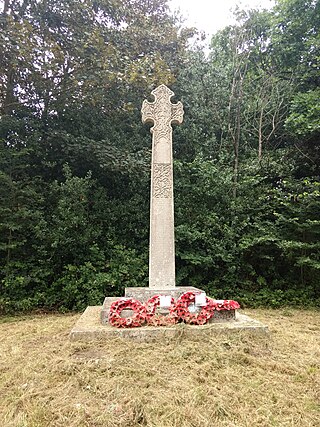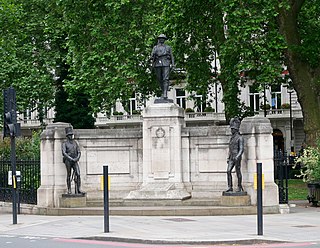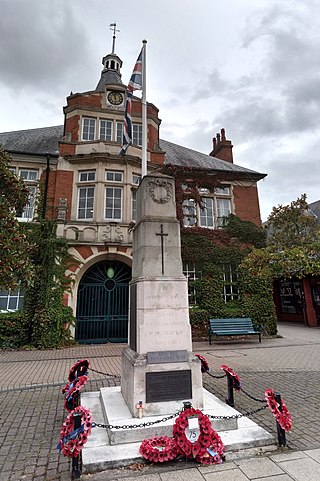
The Eleanor crosses were a series of twelve tall and lavishly decorated stone monuments topped with crosses erected in a line down part of the east of England. King Edward I had them built between 1291 and about 1295 in memory of his beloved wife Eleanor of Castile. The King and Queen had been married for 36 years and she stayed by the King’s side through his many travels. While on a royal progress, she died in the East Midlands in November 1290, perhaps due to fever. The crosses, erected in her memory, marked the nightly resting-places along the route taken when her body was transported to Westminster Abbey near London.

La Délivrance is a 1914 bronze statue by the French sculptor Émile Oscar Guillaume (1867–1942). The statue was created as a celebration of the First Battle of the Marne, when the German army was stopped before capturing Paris in August 1914.

Coade stone or Lithodipyra or Lithodipra is stoneware that was often described as an artificial stone in the late 18th and early 19th centuries. It was used for moulding neoclassical statues, architectural decorations and garden ornaments of the highest quality that remain virtually weatherproof today.

The Polish Air Force Memorial is a war memorial in West London, England in memory of airmen from Poland who served in the Royal Air Force as part of the Polish contribution to World War II. Over 18,000 men and women served in the Polish squadrons of the RAF during the war, and over 2,000 died. The memorial marks the southern extremity of South Ruislip in the London Borough of Hillingdon, near RAF Northolt, where seven Polish-manned fighter squadrons were based at different times in the war.

St Dominic's Priory Church is one of the largest Catholic churches in London. The church is Grade II* listed building on the National Heritage List for England. It has been served by the Order of Preachers (Dominicans) since 1861, the community living in the adjacent Priory. In October 2016, the church was solemnly inaugurated by the Cardinal Archbishop of Westminster, Vincent Nichols, as a diocesan shrine, with a designated mission of promoting the Rosary.

Margravine Cemetery, also known as Hammersmith Cemetery, is in the London Borough of Hammersmith and Fulham. The closest London Underground station is Barons Court.

St Mary the Virgin, Mortlake, is a parish church in Mortlake, in the London Borough of Richmond upon Thames. It is part of the Church of England and the Anglican Communion. The rector is The Revd Canon Dr Ann Nickson.

Chingford War Memorial is a Grade II listed war memorial cross at the junction of King's Head Hill and The Ridgeway, Chingford, London, E4.

The Cavalry of the Empire Memorial, also known as the Cavalry Memorial, is a war memorial in Hyde Park, London. It commemorates the service of cavalry regiments in the First and Second World Wars. It became a Grade II listed building in 1987, and was promoted to Grade II* in November 2014.

St Saviour's War Memorial is a war memorial on Borough High Street, in the former parish of Southwark St Saviour, to south of the River Thames in London. It became a Grade II listed building in 1998 and was upgraded to Grade II* in 2018.

The Anti–Air War Memorial is located in Woodford Green, London, England. It was commissioned and erected by the socialist suffragist Sylvia Pankhurst in 1935 as "a protest against war in the air". It is Britain's first anti-war memorial, and is recorded in the National Heritage List for England as a Grade II listed building.

The Chipping Barnet War Memorial is located immediately west of St John the Baptist Church in Wood Street, Chipping Barnet, Greater London. It commemorates the men and women of the district who died in the first and second World Wars and is in the form of an octagonal base below a pedestal surmounted by a tapering column with a Celtic cross head. The cross is intersected by a corona in a flattened octagonal section. It was unveiled by Lord Byng of Vimy in April 1921. Byng was born at nearby Wrotham Park in Hertfordshire.

The Monken Hadley War Memorial is located immediately to the north of Monken Hadley at the western end of Camlet Way in Monken Hadley Common. It commemorates the men of the district who died in the First and Second World Wars and is in the form of a tapered decorated column with a celtic cross at the top and the names of the dead shown on the shaft. It was unveiled by Francis Fremantle, Member of Parliament for St Albans, in December 1920. It became a Grade II listed building in April 2017.

The principal war memorial in Enfield Town is the cenotaph that stands in Chase Green Gardens and is a grade II listed monument with Historic England. It commemorates men lost in both the World Wars as does a plaque in the town's main post office. In addition, in 2003 a memorial to those lost in the Arctic campaign of the Second World War was unveiled.

The Rifle Brigade War Memorial in London commemorates the service of the Rifle Brigade in the First and Second World Wars. It stands at the junction of Grosvenor Gardens and Hobart Place near Victoria Station in the City of Westminster, on land donated by the 2nd Duke of Westminster.

The Inns of Court Officers Training Corps Memorial is a First World War memorial near Berkhamsted, in the west of Hertfordshire. It is now on land that forms part of Berkhamsted Golf Course. The stone obelisk was erected c.1920, close to the temporary training camp of the corps on Berkhamsted Common which operated from 1914 to 1919. It became a Grade II listed building in November 2016.

The Dulwich Old College War Memorial is located in the forecourt of Dulwich Old College on College Road in Dulwich in the London Borough of Southwark. It marks the deaths of the former pupils of the college who died in the First World War between 1914 and 1919. The memorial is made from Hopton Wood stone and was designed by William Douglas Caröe. It was unveiled in 1921. It has been grade II listed on the National Heritage List for England since May 2010. The heritage listing places the memorial within a "visual and contextual relationship" with the Grade II listed Old College building and the entrance gates and piers of the Old College, also Grade II listed.

The Dulwich College War Memorial is located at the eastern front of Dulwich College on College Road in Dulwich in the London Borough of Southwark. It commemorates the alumni of the college who died in both the First and Second World Wars. The memorial was designed by W. H. Atkin-Berry, an alumnus of the college. It was unveiled on 17 June 1921, the Dulwich College Founder's Day, by Major General Sir Webb Gillman, and dedicated by the Dean of Durham, James Welldon. Gillman was an alumnus of the college, and Welldon had served as Master of Dulwich College from 1883 to 1885. It has been Grade II listed on the National Heritage List for England since May 2010. The heritage listing places the memorial within a "visual and contextual relationship" with the Grade II* listed Main College building.

The British Medical Association War Memorial, officially the War Memorial at British Medical Association House, Tavistock Square, Bloomsbury, London, commemorates men and women of the medical professions from the British Empire and Commonwealth who died in the Second World War. The memorial was commissioned by the British Medical Association and designed by the sculptor James Woodford. Unveiled in 1954 by Sir John McNee, then President of the BMA, and dedicated by Geoffrey Fisher, the Archbishop of Canterbury, it became a Grade II* listed structure in 1998.

New Malden War Memorial is a Grade II listed war memorial in the town of New Malden, Royal Borough of Kingston upon Thames, Greater London, England, commemorating local victims of the First and Second World Wars. Situated in the High Street of New Malden, in front of the erstwhile New Malden Town Hall now owned by Waitrose, New Malden War Memorial comprises a three-tiered cenotaph on a pedestal and two-stepped base.




















